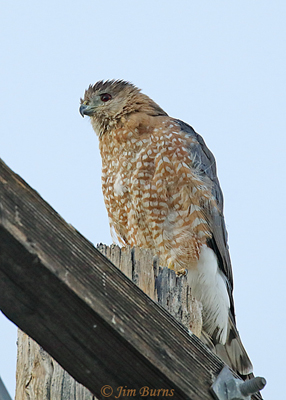
Stretching after an early run on the Scottsdale Greenbelt last month at 5:00am, daylight but not yet sunup, I heard the familiar Kak, kak, kak, sharp, toneless, and irritated, coming from behind the house. In the front door, grab the camera, out the back door. Close now, louder, KAK, KAK, KAK. Above me, on the utility pole in the alley next to our back wall, there she was, probably a female judging by her large size, the first adult Cooper’s Hawk I had ever seen in the city in mid-summer, in blast furnace, pre-monsoon heat.
She sat there for me while I snapped off a dozen frames, hoping something would be sharp in the low light against the backlighting of the sky, then without once looking down in my direction she flew off to the north. Checking the images in the back of the camera, I thought she looked a little disheveled, blew the best one bigger, and realized she looked . . . .wet! Where she was going suddenly became less important than where she had been.
We have a “postage stamp” water feature in our back yard, maybe six feet long by three feet wide, perhaps large enough for a Coop to bathe because I have seen photos of them in residential bird baths. The bigger mystery, though, is how she might have found it, right below her utility pole, but abutting the eight foot high concrete block wall and beneath the heavy foliage of a Texas Olive. It has a drip and a bubbler, and the small neighborhood passerines love it.
I walked over to the pool and, in disbelief, noticed three wet tiles around one edge. Perhaps she had seen doves on the premises, reconnoitered the yard, discovered the water, and . . . well, we know Coops love to bathe. I have photographed them in water on four different occasions and have seen several other similar images. And we’ve had Cooper’s Hawks in the yard before, the first an adult drinking from our front fountain in October, 2009. Since then we’ve watched one flush a Mourning Dove into our kitchen window and have witnessed two actual kills on our property.
Coops, though quiet and reclusive around their nests, have proven to be the most adaptive and opportunistic of North America’s three accipiters. They were first observed nesting in Tucson in the early ‘90s and have been reported there in breeding season ever since. I have not yet heard of nesting evidence in the Valley, but know of three active nests on the Tonto within minutes of residential areas. Since our first yard sighting in ’09, we have recorded the species on our yard list once a year on average, but my recent sighting was the first outside of winter and migration.
Here’s what BNA (Birds of North America) has to say about the apparent expansion: “Affinity for human-altered habitats is possibly because developed areas generally support higher number of favored bird prey. Also, Cooper’s Hawks are adapted to hunting in structurally complex habitats which urban/suburban environments mimic.”
In short, as city folks employ and enjoy more bird feeders and water features we should expect Cooper’ Hawks to begin living amongst us just as the Harris’s Hawks do. Last winter when I asked a non-birding friend why he inexplicably decided to put out seed feeders for “dickey birds” (his term, not mine), his answer was eerily prescient—“I think raptors are cool and I want to see if I can attract some to my yard.” He may not be a birder, but he knows what “raptor” means and why one species has recently moved into our urban neighborhoods.